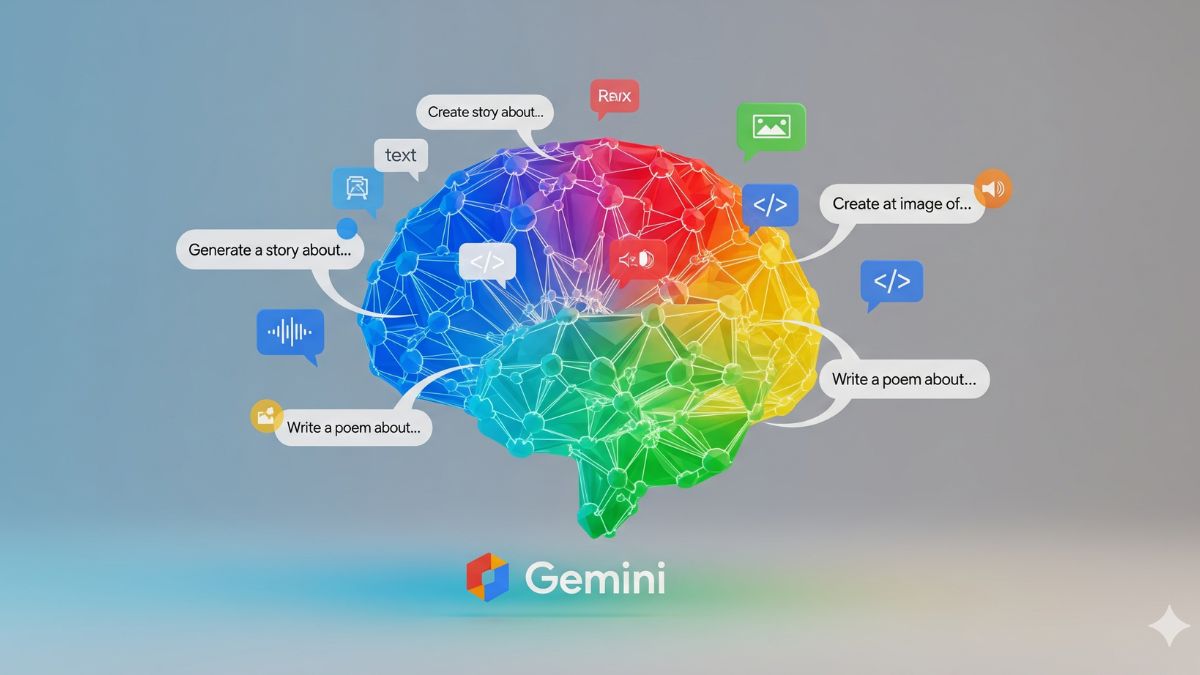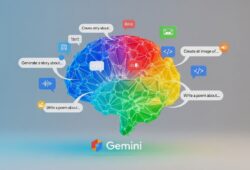
How to create the perfect prompt and not get lost in the process. The “Gemini Prompt Guide for Creatives and Strategists” is a document developed by Google with the goal of helping brands integrate Artificial Intelligence into marketing workflows. Unlike technical manuals, this guide focuses on real-life cases, day-to-day tasks, and how professionals can collaborate with AI as if it were another creative colleague.
AI is no longer just a tool for data analysis or automation: today it is directly involved in idea generation, content production, campaign optimization, and strategic planning. That’s why Google proposes a different approach with Gemini: a multimodal AI that understands text, images, sound, and video, and can assist in both creative and strategic processes—without losing sight of the fact that it cannot replace human talent.
“AI won’t replace your creativity, but it can enhance it if you learn how to prompt effectively,” states the document, emphasizing that AI is a tool to enhance human work—not a threat to replace it. From drafting a pitch to suggesting campaign variations, AI can be as useful as the clarity of the prompt you give it—and that’s where prompts come in.
ALSO READ. What are the 4S of marketing according to Google and why should CMOs know them?
What is a prompt and why is it key when working with Gemini?
A prompt is an instruction or request given to an AI model like Gemini. It is the foundation of the conversation and largely determines the quality and relevance of the response. Google has systematized how to build better prompts into four fundamental blocks:
- Persona: Define the role assigned to Gemini, for example: “You are a senior planner at a creative agency.”
- Task: Clearly specify the task: “Generate three campaign concepts for a sportswear brand.”
- Context: Provide background data to enrich the response: “The brand seeks to connect with a young audience concerned with sustainability.”
- Format: Indicate how the result should be presented: “Return the concepts in list format, including insight, key message, and suggested channel.”
Additionally, the guide recommends writing prompts in natural language, avoiding technical jargon, and adapting and iterating based on the results. It’s not about getting the perfect answer on the first try, but rather about conversing with the AI as you would with a human colleague.
ALSO READ. What should CMOs know about AI, media planning, and strategy, according to Google?
How can marketers use Gemini for analysis and research?
One of Gemini’s strongest capabilities is its ability to read, synthesize, and extract value from large volumes of information. This makes it an ideal tool for traditionally long and complex processes, such as market analysis or audience segmentation.
Here are some of the key uses highlighted in Google’s guide:
- Research Analysis: Summarize consumer studies, trend reports, or internal documents in minutes, highlighting the most relevant data.
- Market Research: Get a snapshot of a specific market, with historical data, future projections, and competitive analysis.
- Audience Research: Suggest consumer profiles suitable for a product or campaign, including motivations, behaviors, and needs.
- Comms Strategy: Generate product use scenarios that feed campaign or activation ideas.
- Strategic Frameworks: Help build frameworks like the “Get/To/By” model by guiding users through strategic thinking questions.
These use cases make Gemini not just an AI assistant but a true strategic copilot for marketers needing speed, accuracy, and depth.
What creative uses does Google’s prompt guide suggest?
Beyond strategy, Google’s guide outlines multiple ways to use Gemini to generate, test, and enhance creative ideas. Here are some of the most inspiring applications from the document:
- Idea Generation: Starting from an insight, ask Gemini to propose creative concepts for campaigns.
- Multiformat: Adapt the same idea across different channels (YouTube Shorts, OOH billboards, podcasts, etc.) with specific prompts for each.
- Influencer Selection: Ask Gemini for recommendations of content creators aligned with the brand and its values.
- Simulated Feedback: Create virtual panels with defined profiles (e.g., “Skeptical Millennial,” “Dog Mom,” “Rational Optimist”) to test a campaign proposal.
- Copywriting: Write headlines, slogans, scripts, or advertising descriptions tailored to different tones, audiences, and platforms.
- Elevator Pitch: Ask Gemini for brief, impactful versions of an idea adapted to different client or CMO profiles.
This approach shows how AI can actively participate in the creative process without eliminating human input. What once required lengthy brainstorming sessions can now start with a well-crafted prompt.
How does Google recommend building an AI culture in marketing teams?
One of the most innovative aspects of the guide is its vision of integrating Gemini not just as a tool but as an active team member. Google encourages building a culture of AI experimentation, allowing teams to learn, share, and grow together.
Recommendations include:
- Include Gemini in the review process of past projects to identify areas of improvement.
- Create an internal “Prompt Library” where the team’s best-used prompts are stored and shared.
- Dedicate five minutes of each weekly meeting to share an AI use case or new discovery.
- Develop personalized “Gems”: customized Gemini setups for specific tasks like report summaries or idea generation.
- Promote the use of multimodal prompts, combining text with images or documents to enrich responses.
What are the risks and opportunities of Gemini in marketing?
Google is also aware that using AI like Gemini must be done responsibly and with discernment. The guide highlights several risks, including:
- Overreliance: Leaving all decisions to AI can hinder originality and critical thinking.
- Standardization of ideas: If everyone uses similar prompts, campaigns could become too similar.
- Ethics and transparency: It’s essential to disclose when content is generated by AI and ensure that biases are not perpetuated.
On the other hand, the opportunities are clear:
- Faster research and production processes.
- Increased productivity without compromising quality.
- Exploring more creative variations before deciding on one.
- Enhanced collaboration among creatives, strategists, and planners using a common tool.










